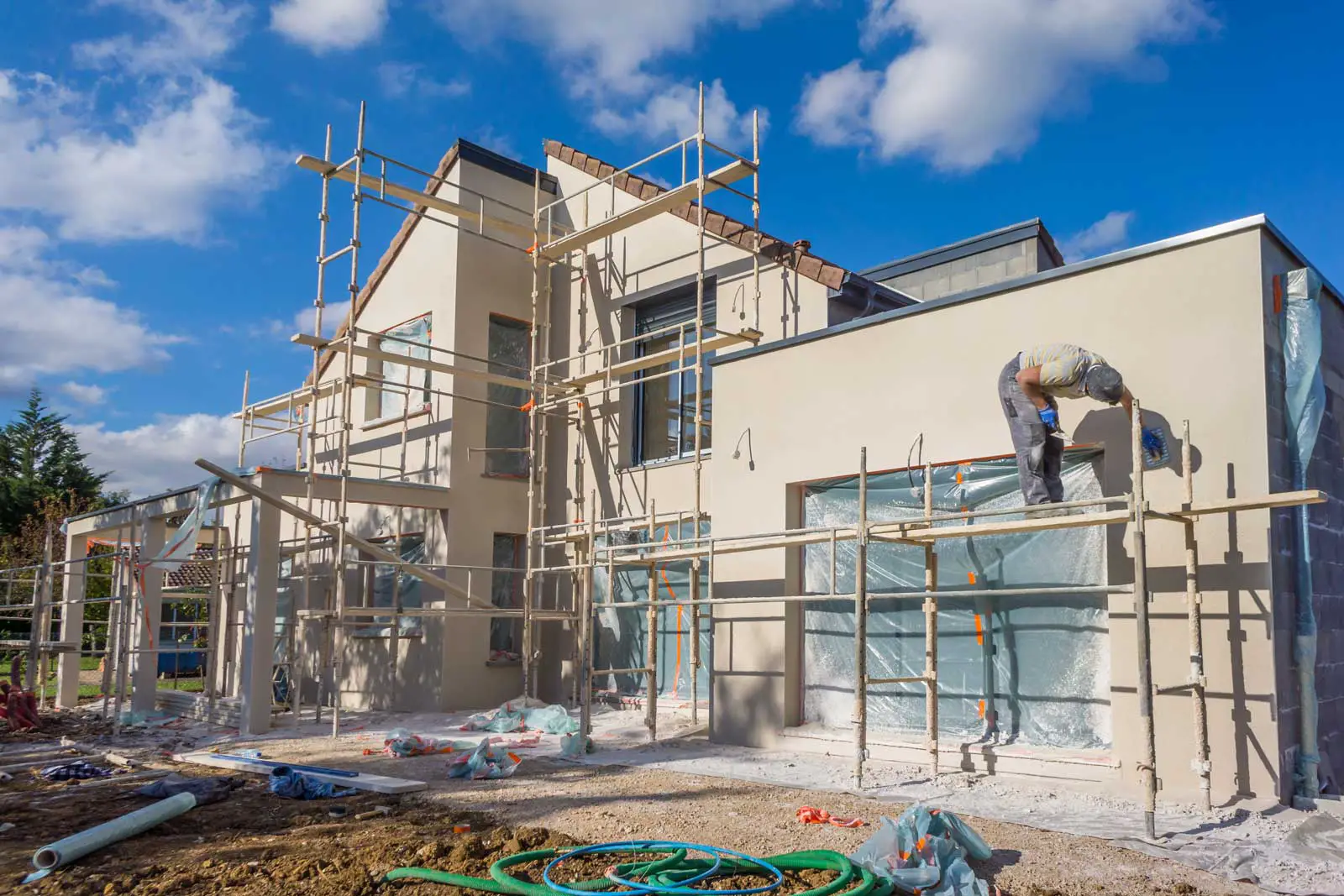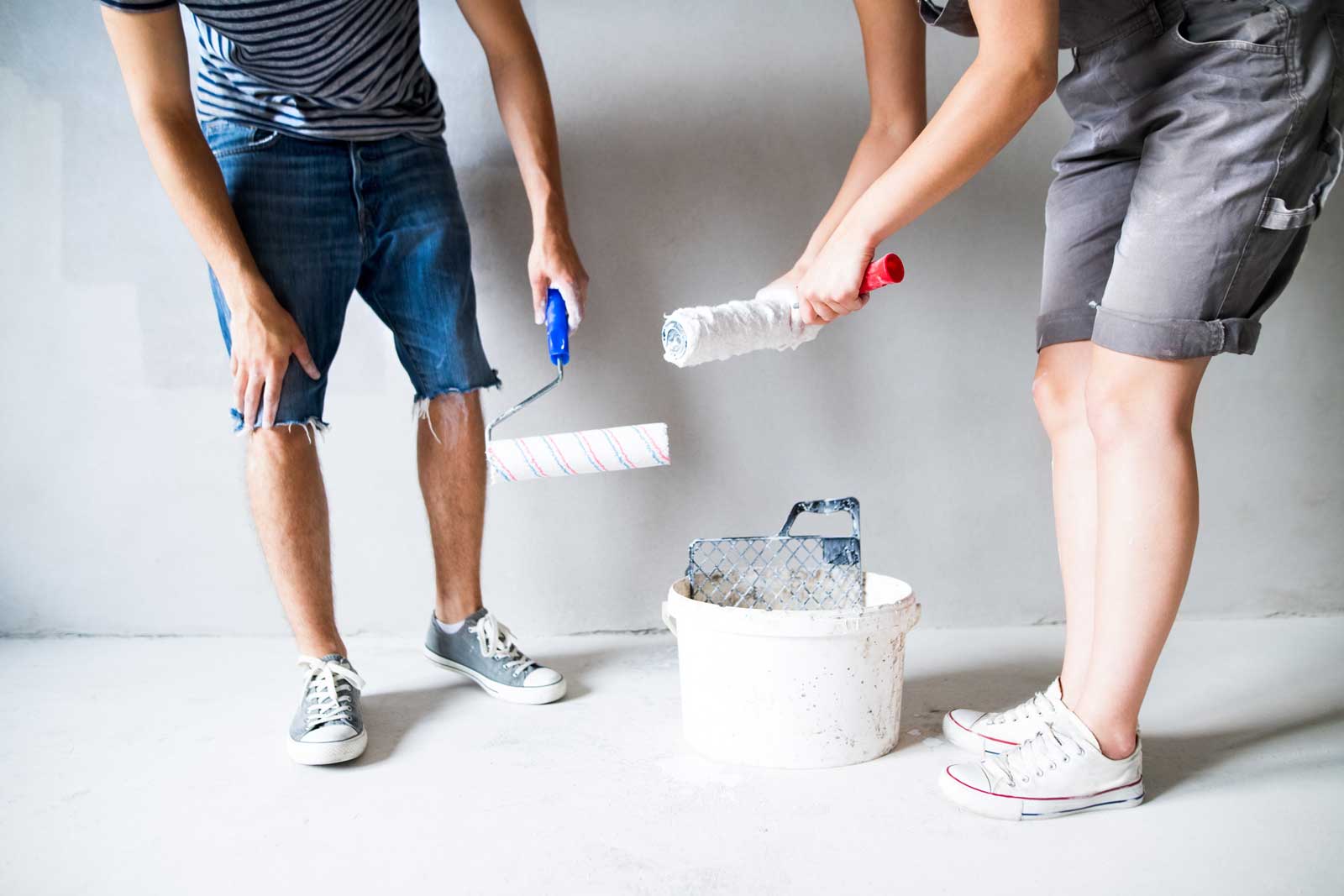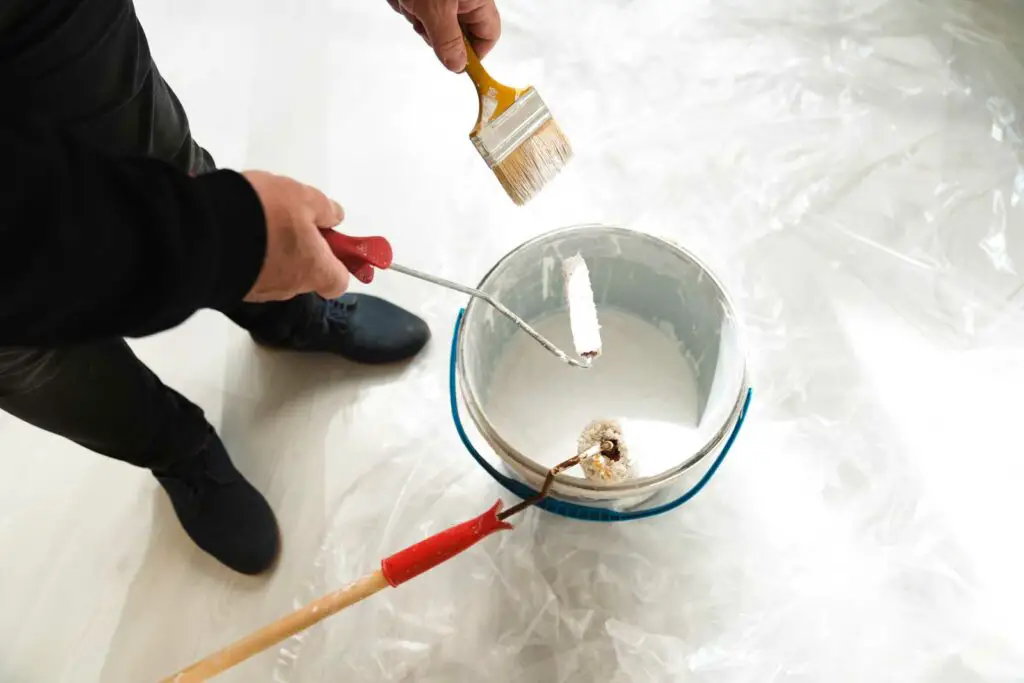If you’re getting ready to start a new painting project you likely have left-over paint and primer from the last job you did.
And you’ve probably found yourself staring at a can of indoor paint primer, wondering if it could really be that harmful to use it on your exterior painting project.
Here’s the brutal truth about using indoor paint primer outdoors: It’s not the best idea. But, why not? Why shouldn’t indoor paint primer be used outdoors?
The short answer is, it’s not recommended. Indoor paint primer is formulated specifically for indoor use and doesn’t have the necessary properties to withstand the external elements that outdoor primers are designed to resist. Using indoor paint primer outdoors could lead to issues with paint adhesion, durability, and overall finish quality. For optimal results and a long-lasting finish, it’s always best to use a primer specifically formulated for outdoor or exterior use. This ensures the primer can handle various weather conditions, temperatures, and the type of surface being painted.
We’ll discuss the key differences between indoor and outdoor primers, the potential risks associated with using indoor primer on exterior walls, and the crucial factors to consider when choosing the perfect primer for your specific needs.
By the way – before we get too far along here, if you want to connect with other homeowners, DIYers, and builders and get more great ideas for your home to make your space the best join my free private Facebook group, Remodel Reality here.
 Can Indoor Paint Primer Be Used Outdoors?
Can Indoor Paint Primer Be Used Outdoors?
Before you reach for that leftover indoor primer for your exterior painting project, let’s take a closer look at the potential risks and impacts on your paint’s adhesion and durability. It’s a question of doing things right, rather than doing them over.
Risks and Potential Issues with Using Indoor Primer Outside
Here’s the brutal truth about using indoor primer outdoors: it’s a gamble.
Indoor primers are specifically designed to work on interior walls and porous surfaces.
When exposed to exterior elements, they just don’t hold up as well. Temperature changes, rain, sunlight… all these can lead to peeling, cracking, and fading.
And if you think that’s bad, consider this:
The primer will probably also fail to block stains and discolorations from showing through your topcoat.
Effect on Paint Adhesion and Durability
When it comes to paint, adhesion and durability are the name of the game. Indoor primers, while excellent for interior use, might not offer the best paint adhesion when used outdoors.
The end result?
A paint job that might look good initially but fails over time.
You see, an indoor primer may not withstand the fluctuating outdoor temperatures or resist the harsh UV rays, leading to a compromised paint layer over time.
Importance of Using the Correct Primer for the Intended Use
“If only it were that easy…” to just use any old primer, am I right?
But the reality is, using the correct primer for the intended use is not just important, it’s critical.
Why, you ask?
Because primers are designed with a specific purpose in mind.
An indoor primer is tailored to bond with interior paint, creating a smooth, uniform base for your color.
An outdoor primer, on the other hand, is engineered to be more resilient, offering better resistance to weather and wear.
The best part?
When you choose the right primer, you’re setting yourself up for success. Your paint will adhere better, the color will stay vibrant longer, and you’ll end up with a paint job that is both beautiful and durable.
So, remember, when it comes to painting: the right tools, the right materials, and the right techniques make all the difference.
It might be tempting to cut corners, but the results speak for themselves. Now, armed with this knowledge, you’re ready to tackle your painting project with confidence!
What is Primer? Why Do I Need To Even Bother?
Stepping into the underappreciated world of primer, it’s more than just an undercoat. (Yes, it’s the unsung hero between your wall and the topcoat.)
Primer, my friends, is the first coat of paint on a surface. (But hold on, it’s not just any paint.)
So, what exactly is a primer?
Primer prepares your surface, akin to a stage being set. It’s the base layer, ensuring adhesion of the paint onto the surface.
Primer is specifically designed to provide a stable base. But wait, there’s more to it!
The purpose of primer in painting transcends its role as a base layer. (Yes, it’s a problem solver!)
Tackling issues like uneven surfaces and small cracks is its game. It’s like a superhero, filling and smoothing porous surfaces.
Primer combats stains, preventing them from bleeding through the topcoat. It even enhances the durability and appearance of the paint layer.
But that’s not all! We have different types of primer. (Surprised?)
Depending on your surface and your desired result, there’s a primer for you. Oil-based primers, latex primers, and shellac primer.
Oil-based primers are your sturdy friends. They are ideal for exterior surfaces and bare wood.
They boast excellent adhesion and stain-blocking qualities. Now, meet latex primers.
Latex primers are the water-based, fast drying type. They are perfect for your interior walls, soft woods, drywall, and concrete.
Lastly, we have the shellac primer. The traditional solution for sealing out the toughest stains and odors.
Whether it’s an interior or exterior painting project, primer plays an essential role. Like a good story, a great paint job begins with a solid foundation.
Differences Between Indoor and Outdoor Paint Primer
In the world of paint primers, one size doesn’t fit all. We’re about to unpack the differences between indoor and outdoor paint primers, and trust me, it’s more than just semantics.
Composition of Indoor and Outdoor Primer
Ever thought about the secret sauce of primers?
Well, it’s all in the composition. Indoor primers are your friendly neighbors, designed to stick well to interior walls, with fewer volatile organic compounds, and a generally low-odor profile.
Outdoor primers?
They’re your superheroes.
Adhering to various exterior surfaces, they’re like a Swiss Army knife in the world of primers, boasting additives to resist mold, mildew, and those pesky UV rays.
Differences in Durability, Adhesion, and Resistance to the Elements
Now, let’s talk durability, adhesion, and resistance. Picture a sprinter versus a marathon runner.
Your indoor primer is the sprinter, crafted for a controlled, indoor environment and a smooth, clean finish. But they’re not really designed to withstand harsh outdoor elements like temperature changes or sunlight.
On the flip side, outdoor primers are your marathon runners.
They’re built for the long haul, able to resist the elements, adhere to the roughest of surfaces, and even block stains. These high-quality primers are robust, flexible, and designed to withstand whatever Mother Nature throws at them.
Importance of Using the Correct Primer for the Intended Use
Lastly, let’s not underestimate the importance of using the correct primer for the job.
Think it’s just an upsell at the paint store?
Think again!
Using an indoor primer for an outdoor project is like trying to grill a steak with a candle; it’s just not the right tool for the job.
Understanding the differences between indoor and outdoor primers is crucial for achieving the best results in your painting projects.
It’s not just about color, but also about the durability, resistance, and overall quality of your paint job.
 Factors to Consider When Choosing Primer for Outdoor Use
Factors to Consider When Choosing Primer for Outdoor Use
Choosing the right primer for outdoor use can feel like navigating a maze. With so many factors to consider, it’s easy to feel overwhelmed. But fear not! We’re about to break down everything you need to know to make the best choice for your project.
Type of Surface Being Painted
The type of surface you’re painting plays a crucial role in the primer you choose. Bare wood, for instance, is thirsty and absorbs paint like a sponge, making a high-quality oil-based primer an excellent choice.
On the other hand, surfaces like aluminum siding or glossy surfaces might benefit more from a bonding primer that can grip onto smooth surfaces.
Weather Conditions and Temperature
Here’s something you might not have considered: the weather conditions and temperature.
Outdoor paint needs to withstand all kinds of weather conditions, from scorching summer heat to freezing winter temperatures.
Some primers are better suited for this task than others.
For example, oil-based primers tend to have a higher resistance to temperature changes, making them a good choice for areas with wide temperature swings.
Type of Paint Being Used
The type of paint you’re planning to use also plays a role in the primer you should choose. Oil-based paints require an oil-based primer for the best results.
On the other hand, water-based paints (like acrylic latex paint) pair well with latex primers.
Stain-Blocking Qualities of Exterior Primer
Last but not least, let’s talk about the stain-blocking qualities of exterior primer. Exterior surfaces often have stains or discolorations that can bleed through your paint if not properly blocked. An exterior primer with excellent stain-blocking qualities can keep those pesky stains at bay, ensuring a smooth and even finish.
Choosing the right primer for your outdoor project doesn’t have to be complicated.
By thinking about these factors, you’re well on your way to a successful paint job that will stand the test of time. Remember, good preparation is key, and that starts with the right primer!
Related and Frequently Asked Questions
You may still have some questions. Here are answers to the most common questions we see on the primer topic.
Q: What primer should I use for an exterior paint job?
A: It’s always a good idea to use a high-quality primer designed for exterior use. Exterior latex primer or oil-based primer are excellent choices. They provide excellent adhesion, better resistance to weather elements, and often contain less pigment which helps the topcoat of paint adhere better.
Q: Can water-based primer be used outside?
A: Yes, water-based primers can be used outdoors, but they are typically best suited for smoother, non-porous surfaces. This is because water-based primers have a harder time adhering to rough or porous surfaces compared to their oil-based counterparts. Therefore, for rough or porous exterior surfaces such as bare wood or masonry, oil-based primers may provide better adhesion and coverage.
Q: How many coats of primer should I apply outside?
A: The best way is to apply at least two coats of primer for the best results. This ensures a uniform base coat for your paint to adhere to.
Q: Why is exterior primer important?
A: An exterior primer seals porous surfaces, blocks stains, and provides a stable base for the paint. It’s an important step that ensures the paint cures properly, leading to a much-needed quality finish.
Q: How warm does it need to be to paint primer outside?
A: Primer and paint should be applied in fair weather conditions. Typically, this is when air temperatures are between 50-85°F (10-29°C). Too cold or too hot can affect how the paint dries and adheres to the surface.
Q: Is oil-based primer better for exterior use?
A: Yes, oil-based primers are typically better for exterior use. They offer excellent adhesion, especially on exterior wood or other porous surfaces, and are more resistant to temperature changes.
Q: Can you mix interior and exterior primer?
A: It’s generally not recommended to mix interior and exterior primer. Each type of primer is designed with specific additives for its intended use, and mixing them may compromise their performance.
Q: How long can interior primer sit before painting?
A: It’s best to follow the manufacturer’s instructions. However, typically, primer should dry for at least 2-4 hours, but can sit for up to 30 days, at room temperature, before painting.
Q: Should I use primer before painting the exterior?
A: Yes. Applying a coat of primer is an important step that helps the paint adhere better, block stains, and provide a smoother finish. It’s particularly important when painting over darker colors, bare wood, or new drywall.
Next Steps
Want to join others who are creating the most amazing home redesigns & renovations and get more tips, tricks and hacks on how to make your home the best it can be?
Join my brand new free private Facebook group, Remodel Reality to connect with other people like you to make your space the best!






